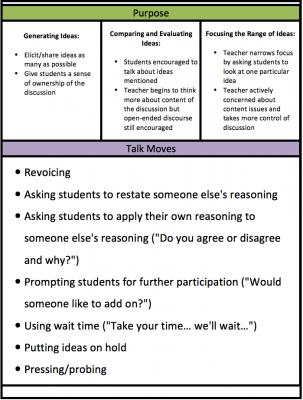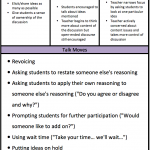I’ve written a post about Talk Moves, called Teacher Moves actually, mostly with regards to Math teaching. Talk Moves, refer to graphic, is actually a set of techniques that can benefit class discussions in any content or grade level, making it an awesome thing to know.
I wanted to write down more Talk Moves than the ones presented in the graphic because I have a list of some really cool moves.
A Structure for Whole Class Discussion
Three Main Parts of a Productive Classroom Discussion:
Generating Ideas:
– Elicit/share ideas as many as possible.
– Give students a sense of ownership of the discussion.
Comparing and Evaluating Ideas:
– Students encouraged to talk about ideas mentioned.
– Teacher begins to think more about content of the discussion but open-ended discourse still encouraged.
Focusing the Range of Ideas:
– Teacher narrows focus by asking students to look at one particular idea.
– Teacher actively concerned about content issues and takes more control of discussion.
Whole Class Talk
Guidelines for Whole-Class Talk:
Explain: “This is my solution/strategy…” “I think _____ is saying that _____.”
– Explain your thinking and show your thinking.
– Rephrase what another student said.
Agree with Reason: “I agree because…”
– Agree with another student and describe your reason for agreeing.
– Agree with another student and provide an alternate explanation.
Disagree with Reason: “I disagree because…”
– Disagree with another student and explain or show how your thinking/solution(s) differs.
Build On: “I would like to build on that idea…”
– Build on the thinking of another student through explanation, example, or demonstration.
Go Beyond: “This makes me think about…” “Another way to think about this is…”
– Extend the ideas of other students by generalizing or linking the idea to another concept.
The Five Practices
Clarify the Content Goals!
- Predicting – What ideas do you think students will have?
- Monitoring – What ideas are emerging? (While they work.)
- Selecting – Which student ideas to use with whole class?
- Sequencing – In what order to use students’ ideas?
- Connecting – What talk moves or other questions can help students compare and connect important ideas?
Discourse Moves (Talk Moves)
- Probing – questions or prompts to get students to make public more of their thinking.
- Re-Voicing – teacher repeats or paraphrases what a student has said in order to achieve instructional goal.
- Pressing – teacher does not allow students to offer shortcut responses, unsupported claims.
- Putting an Idea “on hold” – when topics are entered into the discussion that are off-topic, or are better addressed later on, teachers politely put on hold the introduced idea.
- Using Wait Time – teacher allows adequate wait time following a question (10 sec) depending on type of question.
- Asking Students to Respond to Someone Else’s Reasoning – teacher asks to restate or apply their reasoning to someone else’s.
Talk Formats (Lower Risk)
Individual (lowest risk)
– Clarify my own ideas before hearing others.- Articulate my ideas in written words, drawings.
– Teacher monitors written ideas in the room; may clarify the task and encourage students.
Pairs (low risk)
– Try out my ideas with one other person.
– Practice articulating my ideas in spoken words.
– Hear another’s ideas in relation to mine.
– Teacher monitors written or spoken ideas; may encourage participation or probe students’ thinking; may ask permission to share the pair’s ideas with whole class.
Talk Formats (Higher Risk)
Small Group (medium risk)
– Share and hear ideas from several people.
– Do something with the ideas – sort, organize, compare, prepare for whole-class sharing, etc.
– Equity – are all useful ideas being shared?
– Teacher monitors written and spoken ideas; may probe students’ thinking; may encourage or ask permission for group to share with whole class.
Whole Class (high risk)
– Spread ideas to all students in the room.
– Pair or groups present ideas to whole class.
– Teacher uses talk moves to orchestrate discourse; visual tools help represent and work with various ideas.
The above talk moves reproduced from the Olympic Math and Science Partnership (OMSP).




















































